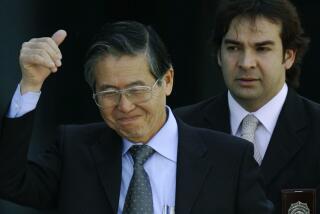Op-Ed: Tojo then, terrorists now: How America’s idea of justice has changed
After U.S. soldiers broke down the door of his Tokyo residence on the afternoon of Sept. 11, 1945, they found Hideki Tojo struggling to stand despite a self-inflicted gunshot wound. Tojo, who was prime minister when Japan attacked the U.S. naval base at Pearl Harbor, chose an unusual weapon for his suicide attempt: a Colt pistol taken from a captured U.S. aviator. With no physician at hand, the last Axis dictator — as most Americans viewed him — seemed to have little time to live.
Tojo survived, however, thanks to U.S. medical care, and because Sgt. John Archinal of Allentown, Pa., donated blood. Archinal’s altruism came with a caveat: “I’m doing this so he can get his just dues and suffer for the 17 months he made me spend in New Guinea,” the site of drawn-out battles between American and Japanese forces. In a U.S. newsreel chronicling the incident, the announcer proclaimed that “like all of us,” Archinal wanted Tojo to live and stand trial.
The shared desire for Tojo to stand trial reflected an American ideal regarding treatment of enemies. After Germany’s surrender in 1945, the U.S. established a war crimes tribunal at Nuremberg to prosecute German leaders instead of summarily hanging them, as Winston Churchill had advocated. American lawmakers and citizens alike also supported a legal reckoning for America’s vanquished Japanese foes. Tojo was tried and convicted — along with 24 other Class-A war criminals — of crimes against peace and humanity at a civilian tribunal convened in Tokyo.
This anniversary of Tojo’s arrest and the Sept. 11 terrorist attacks in the U.S. offers an opportunity to reflect on how American views of justice for national enemies have changed since World War II. Today, 116 suspected terrorists are still being held at the U.S. military base at Guantanamo Bay, Cuba. In recent months, Congress has again debated what to do with the facility, and rehearsed the now-familiar arguments for why we should detain suspected terrorists there and not use civilian tribunals to prosecute them. We have heard that military commissions are the only viable means of justice, and that suspected terrorists would present a grave threat to the homeland if transferred to federal prisons to await trial.
During a Senate hearing in February, Sen. Tom Cotton (R-Ark.) went even further, asserting that if the U.S. had established the Guantanamo facility far earlier, terrorist attacks — stretching back to the 1983 bombing that killed more than 200 U.S. servicemen in Lebanon — would not have taken place. In Cotton’s view, the U.S. government can effectively protect the nation by holding suspected terrorists at Guantanamo indefinitely, apparently without the prospect of trial.
When I hear such pronouncements, I think about John Archinal, and the America that praised his act to save a hated national enemy in order for him to stand trial.
Archinal’s hometown newspaper ran a cartoon that presented the sergeant’s act in a generous light. It depicts a caricatured Japanese attendant asking Tojo, recuperating in bed, how he feels. The smiling ex-premier replies, “Tzimlich Gude!” which means “pretty good” in Pennsylvania Dutch, an apparent reference to the benefits provided by Archinal’s eastern Pennsylvania blood. Newspapers across the country followed Archinal’s trip home in October 1945. Reporters also queried him on Dec. 23, 1948, when Tojo was hanged, at which time Archinal affirmed that “I gave my blood so he [Tojo] could be brought to justice, and that is exactly what he got.”
The Tokyo war crimes tribunal, where Tojo faced justice, was far from a model proceeding. Gen. Douglas MacArthur, the head of the Allied occupation, viewed the tribunal primarily as a political tool to help rebuild Japan and, in a decision that is still controversial, chose not to try Emperor Hirohito so that he could remain on the throne and provide stability. The U.S. pushed the narrative that successive military and civilian leaders had steered Hirohito into supporting wars of imperial expansion beginning in the early 1930s.
After a proceeding that began in April 1946 and stretched until November 1948, the tribunal convicted Tojo and other leaders of maintaining a nearly two-decade conspiracy of national aggression, even though many of the men had never met before the trial.
Today’s extended detentions of suspected terrorists prompt us to view the Tokyo trial in a different light. That tribunal, fraught with inconsistencies and taking more than 2 1/2 years to complete, can now be seen as an example of speedy justice.
Robert Hellyer is an associate professor of history at Wake Forest University.
Follow the Opinion section on Twitter @latimesopinion and Facebook
More to Read
A cure for the common opinion
Get thought-provoking perspectives with our weekly newsletter.
You may occasionally receive promotional content from the Los Angeles Times.










